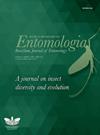Is a diet of Planococcus citri nymphs and adults suitable for Chrysoperla externa for use in biological control?
IF 1.3
4区 农林科学
Q4 ENTOMOLOGY
引用次数: 1
Abstract
Several studies have shown that the survival and reproduction of lacewings varies depending on the type of prey they consumed, especially during the first instar. In this study, we evaluated the effect of a diet consisting of Ephestia kuehniella (EK) and/or Planococcus-citri (PC) eggs offered to first instar Chrysoperla externa on subsequent development and survival. Larvae supplied only with P. citri (PC) nymphs had extended immature development, low survival, adults with lower weight and longevity, low fecundity and egg viability, and lower net reproduction rate (R 0 ). Larvae submitted to the treatment EK+PC responded positively to the diet, showing results similar to those obtained in the control-EK treatment. Therefore, this mealybug supports suitable development and reproduction of C. externa when it is provided to second instar larvae after they fed on E. kuehniella eggs as first instars. As far as we know, this is the first report that demonstrates the effect of natural prey and alternatives on different larval stages of lacewings. This information is valuable in developing protocols for use of C. externaas a pest control agent.以柑橘扁球菌若虫和成虫为食,是否适合于对外菊花进行生物防治?
本文章由计算机程序翻译,如有差异,请以英文原文为准。
求助全文
约1分钟内获得全文
求助全文
来源期刊
CiteScore
1.50
自引率
12.50%
发文量
14
审稿时长
6-12 weeks
期刊介绍:
Information not localized

 求助内容:
求助内容: 应助结果提醒方式:
应助结果提醒方式:


